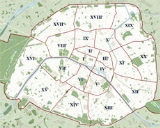
Boulevard de Clichy
Encyclopedia
The Boulevard de Clichy (bulvaʁ də kliʃi), which lends its name to the Place de Clichy
, resulted from the fusion, in 1864, of the roads that paralleled the Wall of the Farmers-General
, both inside and out. It extends from the Place de Clichy
to the Rue des Martyrs, nearly a kilometre away. During its tenure, the street has been known as the Boulevard des Martyrs, then the Boulevard Pigalle, and, finally, the Boulevard de Clichy. It is equally well-known as the Boulevard Clichy.



Place de Clichy
The Place de Clichy, also known as "Place Clichy", is situated in the northwestern quadrant of Paris. It is formed by the intersection of the Boulevard de Clichy, the Avenue Clichy, the Rue Clichy, the Boulevard des Batignolles, and the Rue d'Amsterdam....
, resulted from the fusion, in 1864, of the roads that paralleled the Wall of the Farmers-General
Wall of the Farmers-General
The Wall of the Farmers-General was built between 1784 and 1791 by the Ferme générale, the corporation of tax farmers. It was one of the several city walls of Paris built between the early Middle Ages to the mid 19th century. It was 24 kilometers long and roughly followed the route now occupied by...
, both inside and out. It extends from the Place de Clichy
Place de Clichy
The Place de Clichy, also known as "Place Clichy", is situated in the northwestern quadrant of Paris. It is formed by the intersection of the Boulevard de Clichy, the Avenue Clichy, the Rue Clichy, the Boulevard des Batignolles, and the Rue d'Amsterdam....
to the Rue des Martyrs, nearly a kilometre away. During its tenure, the street has been known as the Boulevard des Martyrs, then the Boulevard Pigalle, and, finally, the Boulevard de Clichy. It is equally well-known as the Boulevard Clichy.
Notable buildings on the Boulevard de Clichy
- No. 6, Boulevard de Clichy: The painter, Edgar DegasEdgar DegasEdgar Degas[p] , born Hilaire-Germain-Edgar De Gas, was a French artist famous for his work in painting, sculpture, printmaking and drawing. He is regarded as one of the founders of Impressionism although he rejected the term, and preferred to be called a realist...
, lived here; he also died on the fifth floor of this house, in 1917, aged 83. - No. 11: This house was occupied by Théophile DelcasséThéophile DelcasséThéophile Delcassé was a French statesman.-Biography:He was born at Pamiers, in the Ariège département...
, for many years the French Foreign Minister, and it was also the rented quarters of many artists, among them Pablo PicassoPablo PicassoPablo Diego José Francisco de Paula Juan Nepomuceno María de los Remedios Cipriano de la Santísima Trinidad Ruiz y Picasso known as Pablo Ruiz Picasso was a Spanish expatriate painter, sculptor, printmaker, ceramicist, and stage designer, one of the greatest and most influential artists of the...
in 1909. - No. 12: This was the pied-à-terre, in 1910, of the painter, Francis Tattegrain.
- No. 18, Boulevard Pigalle: Here, the American painter, James Abbott McNeill Whistler, executed the portrait of Joanna HiffernanJoanna HiffernanJoanna "Jo" Hiffernan was an Irish artists' model and muse who was romantically linked with American painter James Abbott McNeill Whistler and French painter Gustave Courbet.-Early life:Hiffernan was a Roman Catholic...
, a painting known as La Fille Blanche, during the winter of 1861–1862. - No. 36: Now the Paris headquarters of the Lebanese comedy troupe, the Théâtre de Dix-HeuresThéâtre de Dix-HeuresLe Théâtre de Dix-Heures was a Lebanese theatrical group specialising in comedy, which functioned between 1962 and 1978 before being revived in 1986.-History:...
, this building was the home of Honoré DaumierHonoré DaumierHonoré Daumier was a French printmaker, caricaturist, painter, and sculptor, whose many works offer commentary on social and political life in France in the 19th century....
, the characaturist and painter, from 1869 to 1873. - No. 54: This is the site of two old and much-missed cabarets, Le Ciel (Heaven) and Enfer (Hell).
- No. 65: The painter, Jean-Léon GérômeJean-Léon GérômeJean-Léon Gérôme was a French painter and sculptor in the style now known as Academicism. The range of his oeuvre included historical painting, Greek mythology, Orientalism, portraits and other subjects, bringing the Academic painting tradition to an artistic climax.-Life:Jean-Léon Gérôme was born...
, established his studio here and died at work in 1904; later, it became the location of the Jules FerryJules FerryJules François Camille Ferry was a French statesman and republican. He was a promoter of laicism and colonial expansion.- Early life :Born in Saint-Dié, in the Vosges département, France, he studied law, and was called to the bar at Paris in 1854, but soon went into politics, contributing to...
lycée (secondary school). - No. 68: This is the second, and ultimate, home of the old cabaret, Le Chat noirLe Chat NoirLe Chat Noir was a 19th-century cabaret, meaning entertainment house, in the bohemian Montmartre district of Paris...
(The Black Cat), which originally opened around the corner at 84 Boulevard Rouchechouart. This place was much-esteemed for its excellent (and surprising) entertainments. - No. 72, Boulevard de Clichy: Musée de l'Erotisme (Museum of EroticismMuseum of EroticismMuseum of Eroticism is a sex museum in Paris devoted to the erotic art collections of antique dealer Alain Plumey and French teacher Jo Khalifa. Founded in 1997, the museum is situated in the Pigalle district of Paris, at 72 Boulevard de Clichy...
) - No. 82: Beginning in 1889, this is where the Moulin-Rouge (Red Windmill), the home of the can-can, opened its doors. It was founded by Joseph OllerJoseph OllerJoseph Oller was a Spanish Catalan entrepreneur who lived in Paris for most of his life. He founded the famous cabaret Moulin Rouge and was the inventor of the parimutuel betting....
. - No. 100: Now the Théâtre des Deux Ânes (Two Donkeys Theatre), this building was once the cabaret known as the Cabaret des Truands (Cabaret of Truants).
Métro stations
The Boulevard de Cichy is It is served by the 2, 12, and 13 lines.



